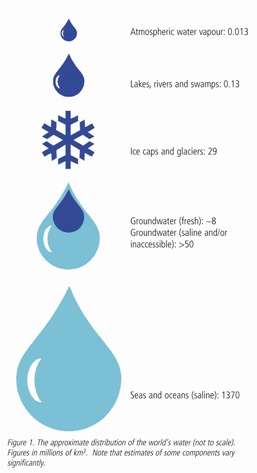
Hydrogeologist Michael Price* discusses UK geology and water supply in a changing climate.
Geoscientist 18.2 February 2008
In the spring of 1992 the east of England and Scotland were facing their fourth year of exceptionally low rainfall. I drafted an article about drought and groundwater and sent it off to The Independent. After it had matured for a few weeks, and we had had an unusually wet April and May, I was contacted: processes akin to tectonics had brought my piece to the top of the editor’s pile. Given recent rain, he reasonably asked, was the issue still relevant? Oh yes, I assured him; it would take months of heavy rain to make any impact on the situation before winter. The article was duly published and months of heavy rain were what we got. Ever since, whenever we have a dry spring, members of my family plead with me not to spoil it by writing “another rainmaking article”. In late 2007, with parts of the country disappearing under water, it seems a good time to take stock of the water-supply situation in Britain and to consider how we, and the rest of the world, might be affected by climate change.
We all need water and fortunately, Earth has plenty. The bad news is that – like money – most of it is locked up in reserves with relatively little in circulation. The water in stores is also mostly not of the right quality or in the right places for us to be able to use it easily.
Of all the water on Earth (Fig. 1), the largest store is the oceans, which (including sea ice) are generally reckoned to hold around 1370 million cubic kilometres (km3). The next largest obvious stores are the icecaps of Antarctica and Greenland which, together with smaller land ice masses, are thought to hold about 27.65 million km3 (IPCC 4th Assessment). Although many cities – including London - are looking to sea water desalination (and there has been talk of towing icebergs from the Antarctic or elsewhere) neither of these large stores is of much direct use.
Instead, we look to more obvious sources – rivers, lakes and the ground. The circulation system – the “hydrological cycle” – means that all these are ultimately replenished by precipitation from a relatively tiny store of water in the atmosphere – about 0.013 million km3. The relative size of the oceans and the atmospheric store, and the quantity of average precipitation, mean that the average water molecule in the cycle spends about 3000 years in the ocean but only about 10 days in the atmosphere.
Three points are worth noting.
- Water is a stable substance and the amount of water on Earth is pretty well fixed, so we are using the same water as the Romans and the dinosaurs.
- Precipitation from that relatively tiny atmospheric store provides every man, woman and child on Earth with an average of about 60,000 litres of water a day.
- For Great Britain, the average supply from precipitation is about 12,000 litres per person per day. In comparison, the average daily use of water from public supplies is about 340 litres/person-day of which something like 150 to 175 litres are used in the home and the remainder in offices, shops, schools, etc., supplied from the mains.
With figures like that, we may well ask why we have water shortages at all. There are two main reasons. The first is that we do not get to use all that water that falls from the sky; much evaporates, and we have to share it with other creatures. The second is that the ‘average’ doesn’t happen very often, or in many places. If everywhere on Earth received ‘average’ rainfall every day, water resources planners would be out of a job. It is interesting though to note the correspondence between average annual precipitation (Fig. 2) and world population density (Fig. 3). People tend not to live in deserts or tundra.